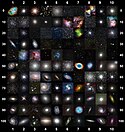M27 - Dumbbell Nebula
The Dumbbell Nebula — also known as Messier 27 or NGC 6853 — is a typical planetary nebula and is located in the constellation Vulpecula (The Fox). The distance is rather uncertain, but is believed to be around 1,200 light-years. It was first described by the French astronomer and comet hunter Charles Messier who found it in 1764 and included it as no. 27 in his famous list of extended sky objects [2] .Despite its class, the Dumbbell Nebula has nothing to do with planets. It consists of very rarified gas that has been ejected from the hot central star (well visible on this photo), now in one of the last evolutionary stages. The gas atoms in the nebula are excited (heated) by the intense ultraviolet radiation from this star and emit strongly at specific wavelengths.
This image is the beautiful by-product of a technical test of some FORS1 narrow-band optical interference filtres. They only allow light in a small wavelength range to pass and are used to isolate emissions from particular atoms and ions. In this three-colour composite, a short exposure was first made through a wide-band filtre registering blue light from the nebula. It was then combined with exposures through two interference filtres in the light of double-ionized oxygen atoms and atomic hydrogen. They were colour-coded as “blue”, “green” and “red”, respectively, and then combined to produce this picture that shows the structure of the nebula in “approximately true” colours.
They are three-colour composite based on two interference ([OIII] at 501 nm and 6 nm FWHM — 5 min exposure time; H-alpha at 656 nm and 6 nm FWHM — 5 min) and one broadband (Bessell B at 429 nm and 88 nm FWHM; 30 sec) filtre images, obtained on September 28, 1998, during mediocre seeing conditions (0.8 arcsec). The CCD camera has 2048 x 2048 pixels, each covering 24 x 24 µm and the sky fields shown measure 6.8 x 6.8 arcminutes and 3.5 x 3.9 arcminutes, respectively. North is up; East is left.
Credit:
ESO/I. Appenzeller, W. Seifert, O. Stahl, M. Zamani
Coordinates Position (RA): 19 59 36.41 Position (Dec): 22° 43' 16.00" Field of view: 6.76 x 6.82 arcminutes Orientation: North is 0.0° left of vertical
Colours & filters Band Wavelength Telescope Optical u 361 nm Very Large Telescope FORS1 Optical B 429 nm Very Large Telescope FORS1 Optical Oiii 501 nm Very Large Telescope FORS1 Optical HeII 472 nm Very Large Telescope FORS1 Optical R 655 nm Very Large Telescope FORS1 Optical H-alpha 656 nm g Very Large Telescope FORS1.
This media was created by the European Southern Observatory (ESO).
Their website states: "Unless specifically noted, the images, videos, and music distributed on the public ESO website, along with the texts of press releases, announcements, pictures of the week, blog posts and captions, are licensed under a Creative Commons Attribution 4.0 International License, and may on a non-exclusive basis be reproduced without fee provided the credit is clear and visible." To the uploader: You must provide a link (URL) to the original file and the authorship information if available. | |
Diese Datei ist lizenziert unter der Creative-Commons-Lizenz „Namensnennung 4.0 international“.
| |
Relevante Bilder
Relevante Artikel
HantelnebelDer Hantelnebel ist ein rund 1300 Lichtjahre entfernter, 7,5 mag heller planetarischer Nebel im Sternbild Fuchs. Der Nebel ist vor ungefähr 10.000 Jahren aus der von einem Roten Riesenstern in seiner Endphase abgestoßenen Hülle entstanden und dehnt sich mit einer Geschwindigkeit von circa 30 km/s aus. Der Kern des Riesensterns ist dabei als über 100.000 Kelvin heißer Weißer Zwerg von 14 mag Helligkeit im Zentrum des Nebels verblieben. .. weiterlesen









